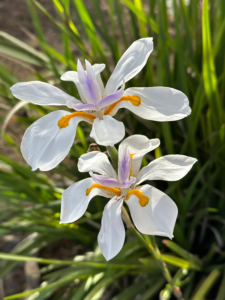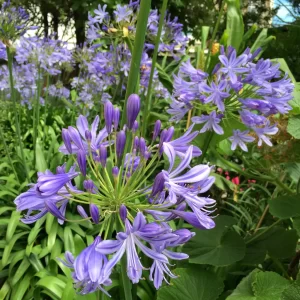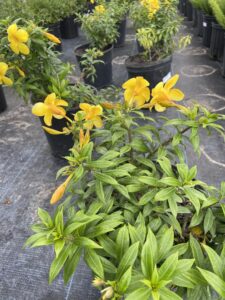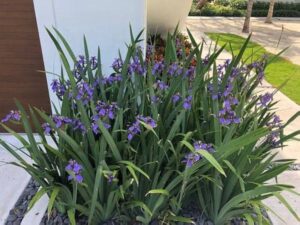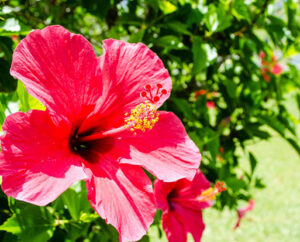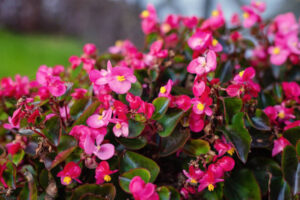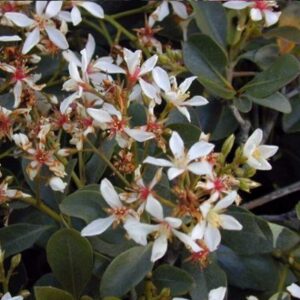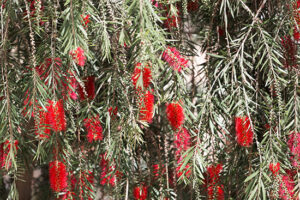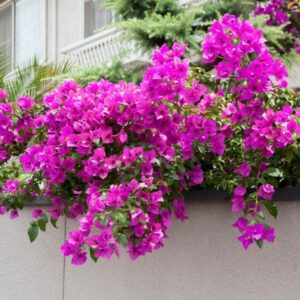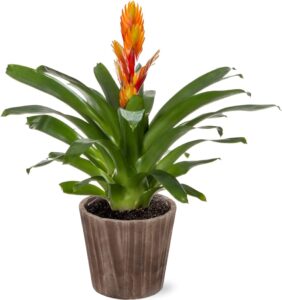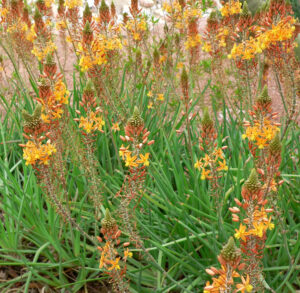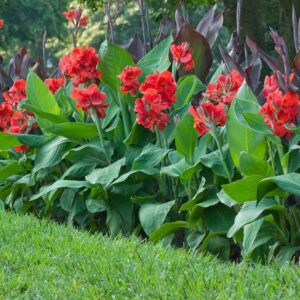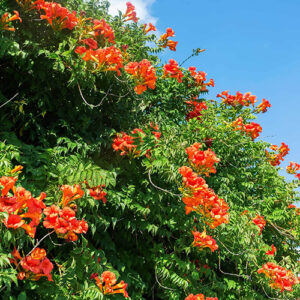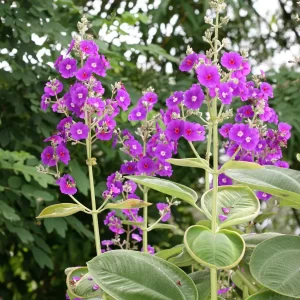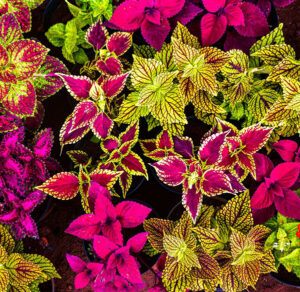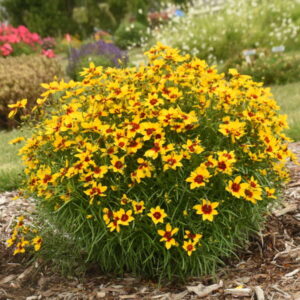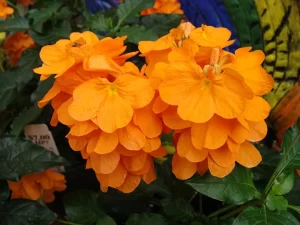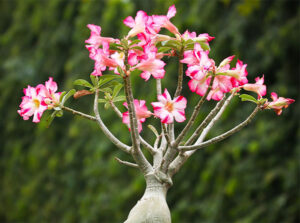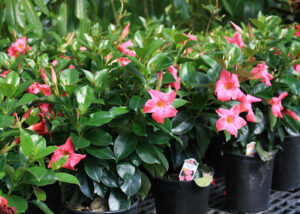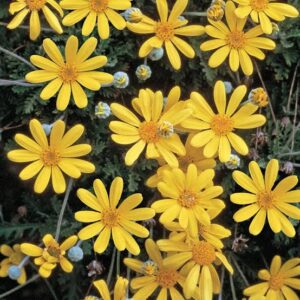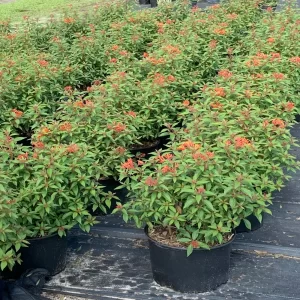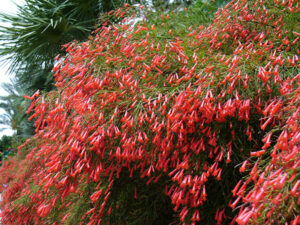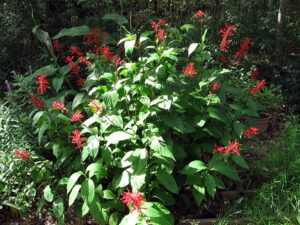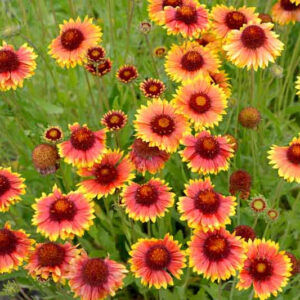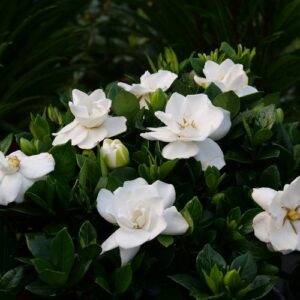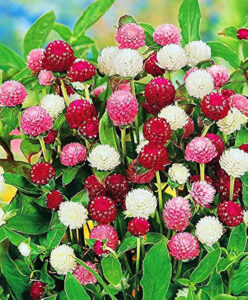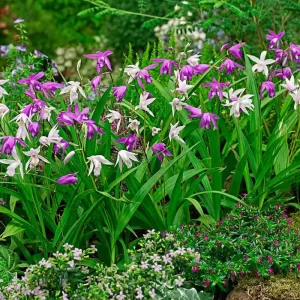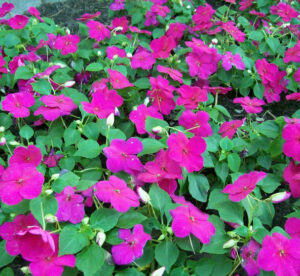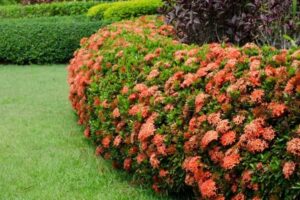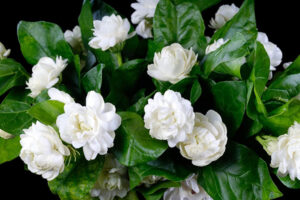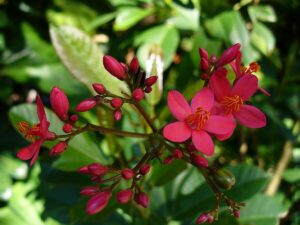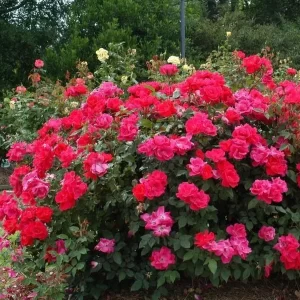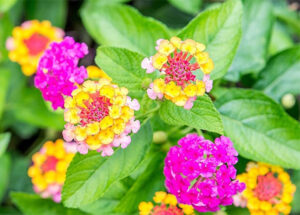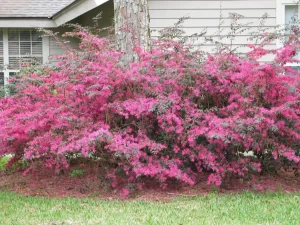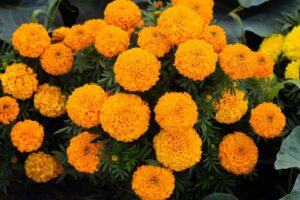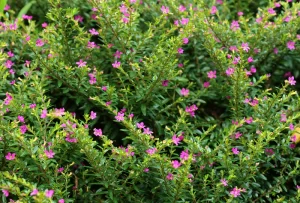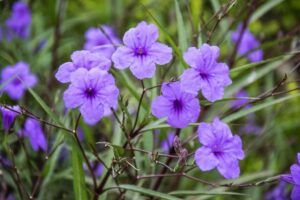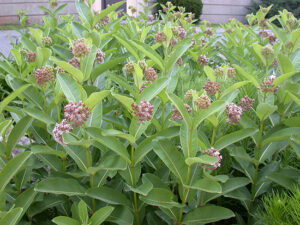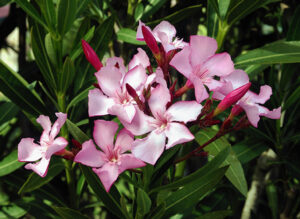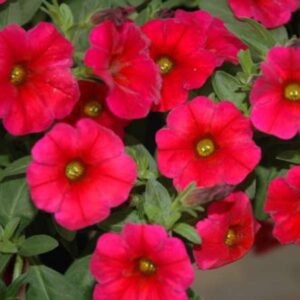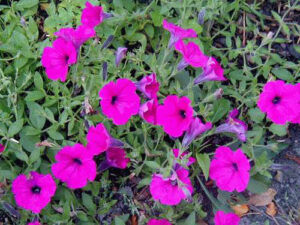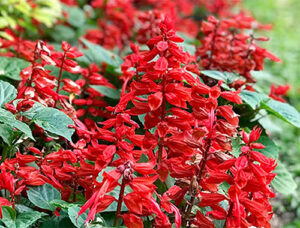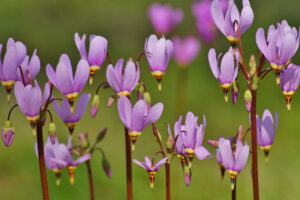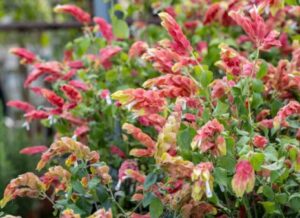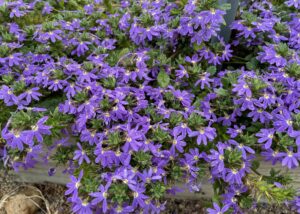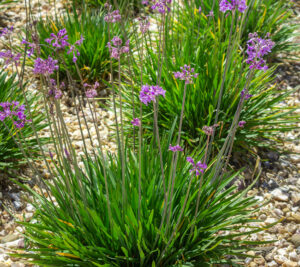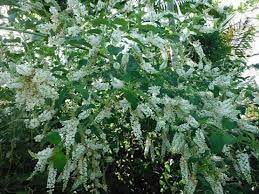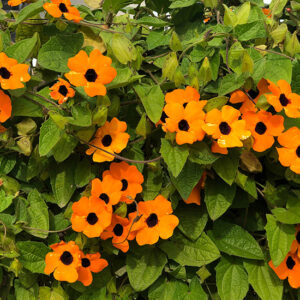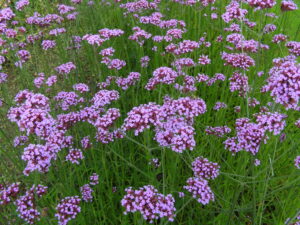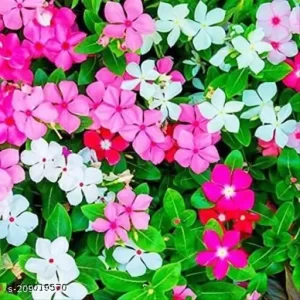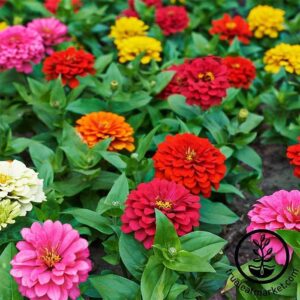PLANT CATALOG
Dietes iridiodes - The African Iris flowers are unique and striking, blooming primarily in spring and summer and periodically throughout the winter. Younger plants are flowerless, but within 2 years of its initial planting, the African Iris will begin to flower year-round. Although the flowers are short-lived, they are numerous; with each stalk producing a large supply of buds.
Agapanthus orientalis - Agapanthus is a summer-flowering bulb for Southern gardens. Sometimes called African lily and lily of the Nile, it is originally from South Africa. Agapanthus makes an elegant addition to any landscape. Its strap-like leaves make an excellent ground cover and its conspicuous flowers bloom all summer long.
Agapanthus can bring fresh shape to your cut flower garden. It will liven up a Florida-friendly landscape by attracting hummingbirds and other pollinators. The blooms are absolutely unique and make a wonderful display in mass plantings.
Allamanda cathartica - An evergreen tropical climber with large, deep yellow trumpet flowers and glossy green leaves. Native to Brazil, its flowers are visited by bees, sunbirds and butterflies. Allamanda makes a lush addition on trellises or fences in parks and gardens and flowers freely all year.
Neomarica spp. - Apostle Iris is a clumping herbaceous perennial with long, glossy green leaves and small, iris-like flowers. The flower color will vary depending on the species; they can be white, yellow, or blue-purple. Apostle Iris sports interesting flowers, with outer petals that spread almost horizontally.
As they grow, the stalks bend to the ground and the plantlet takes root. Eventually, the new plant will repeat the same process. In this way many walking iris plants “walk” through the landscape.
Wrightia antidysenterica - Asian snow blooms with small white flowers all year long. This well-behaved plant requires very little trimming and keeps a neat shape. It can take full sun or part-shade and will grow to five to six feet tall. Asian snow is great for containers and small spaces in the landscape.
The Asian Snow Bush produces fragrant sprays of delicate, snow-white blooms. This well-mannered little bush needs little to no pruning to keep its tidy appearance.
Hibiscus syriacus - Hibiscus is a large genus of flowering plants in the Malvaceae or mallow family.
They prefer a sunny location and well-drained soil that contains plenty of organic matter. Hibiscus will tolerate light shade and less desirable soils, but their vigor and flowering will be reduced. Plenty of water is necessary for the most abundant blooming. Newly planted hibiscus will need more frequent watering, similar to other newly planted perennials.
Begonia
Begoniaceae - For beautiful foliage and a constant display of color throughout the season, grow begonias. Begonias are grown for their foliage and or attractive flowers. Some begonias, such as wax begonias and newer hybrid begonias, will continually flower throughout the summer. They can be used as bedding plants and in window boxes, hanging baskets, and other containers. Another benefit of planting begonias is that they are deer and rabbit-resistant.
Strelitzia reginae - Bird of Paradise is a striking evergreen plant with blue-green foliage and showy orange and blue blooms that resemble a bird in flight. Its drought tolerance and pest resistance make it a favorite low-maintenance tropical plant.
The ideal planting location will have fertile, well-drained soil that is high in organic matter. It should have partial shade with minimal salt (light spray is tolerated). Plants grown in part shade will grow taller and have larger flowers than those planted in full sun. If you are going for a dramatic landscape feature, space your plants about six feet apart to allow room for the flowers.
Plant bird of paradise in a groundcover or in front of a shrub border to highlight the blue tones in its foliage against the green shrubs. It is also ideal for planting next to pools and patios since it doesn’t tend to cause leaf litter.
Rhaphiolepis indica, the Indian hawthorn
Indian Hawthorn is popular as an ornamental plant in gardens and landscapes due to its attractive foliage and colorful flowers. It can be grown as a standalone shrub or in hedges and borders. It prefers well-drained soil and a sunny to partially shaded location. The Indian Hawthorn plant typically blooms in spring, producing numerous flowers in tight clusters. The flowers have a pleasant fragrance and are attractive to pollinators like bees and butterflies.
Plumbago auriculata 'Imperial Blue' - Growing in billowing drifts with breathtaking flowers, blue plumbago is an easy-care, showy shrub with cottage garden appeal.
'Imperial Blue' is the most popular cultivar, with butterfly-attracting blossoms in vibrant blue with a hint of violet.
Callistemon spp. - A popular drought-resistant perennial, this unique shrub produces bottle-brush like bright red blooms and attracts hummingbirds!
Some bottlebrushes are naturally dense and compact making good informal hedges; others are sparse and open (they can be pruned up to become small trees).
Bougainvillea 'Elizabeth Angus' - Bold, in your face color and impressive form, the Elizabeth Angus Bougainvillea is a heat-loving flowering shrub that displays vivid purple flower-like petals, called bracts, that smother these plants! Forming upright vining stems and multiple climbing branches, these plants can be kept as climbers, trained into an ornamental tree form, or pruned as a low-growing shrub.
These broadleaf evergreens offer year-round color with their glossy deep green leaves and become especially lit up when the dramatic three-petaled bracts form! Each is highlighted by a pale yellow stamen in the centers, no one will be able to take their eyes off them each year! These lovelies bloom throughout the spring, summer, and fall because of the long-lasting bracts!
Fast-growing Elizabeth Angus is evergreen throughout USDA growing zones 9 through 11, and tolerates almost any warm climate condition, moderately moist soil, and loves the heat and sun! Botanically a vine, these form woody stems that can be trained into trees and shrubs with some pruning. Growing into an 8-12 feet mature height and a 4-6 foot wide woody vine!
Bromeliaceae genera - Bromeliads, with their rigid and often colorful rosettes combined with futuristic-looking flowers, are one of the more fascinating houseplants. Bromeliads need to mimic their native climate range and weather. Their care also hinges upon how the plant gathers moisture and nutrients in the wild.
Bulbine has become a popular plant in Florida because it is drought tolerant, grows well in poor soils, and blooms repeatedly with cheerful flowers that are yellow or orange, depending on the variety.
The succulent, grass-like foliage grows to about a foot tall, while the flower stalks typically reach two feet, dancing above the leaves throughout the summer months.
This plant offers clumping succulent foliage and tall flower stalks that bloom with yellow flowers from spring to fall. Bulbine grows 12-18" tall and 12-24" wide, spreading by rhizomes for even more plants to divide and replant.
Calibrachoa Solanaceae - Calibrachoa plants are annuals known for their small, colorful flowers that bloom all season with little maintenance. Grow calibrachoas in pots, hanging baskets or window boxes.
These fast growers are annual in colder climates and short-lived perennials in warmer regions. They are also deer-resistant, making them a great choice for gardeners who struggle with deer nibbling on their plants.
Despite their delicate appearance, these tiny petunias are quite hardy and can withstand a range of conditions, including partial shade and frost.
Canna glauca - This vibrant plant adds tall, tropical scenery to a landscape! Flashy and flamboyant, canna lilies are perennial flowers that thrive in the heat of July and August.
This flowering perennial plant is related to bananas and gingers! This may not be surprising when you consider their huge paddle-shaped leaves.
Tecomaria capensis - Like jewelry for your yard, gorgeous cape honeysuckle is a show-stopper with its stunning clusters of trumpet-shaped orange blossoms and fern-like foliage.
This wide-spreading shrub blooms on and off all year, and makes a fabulous flowering hedge that attracts butterflies and birds including hummingbirds.
Tibouchina urvilleana - This sprawling, evergreen shrub or small ornamental tree ranges from 10 to 15 feet (20 feet with proper training) in height. It can be trimmed to any size and still put on a vivid, year-long flower display. The dark green, velvety, four to six-inch-long leaves have several prominent longitudinal veins instead of the usual one, and are often edged in red. Large, royal purple blossoms, flaring open to five inches, are held on terminal panicles above the foliage, creating a spectacular sight when in full bloom.
Clerodendrum quadriloculare - Fast-growing starburst clerodendrum grows well in zones 9b to 11 and can be used as a shrub or tree. Typically reaching a height of 15 feet, this plant is most eye-catching in mid-winter and early spring when its showy tubular flowers—white-tipped and pink below—appear in large clusters. Hummingbirds and long-tongued butterflies love to visit these tubular flowers for their sweet energizing nectar.
The rest of the year, it’s the foliage that’s the point of interest. The topsides of the leaves are green, with just a tinge of purple, while the undersides are a glossy, deep purple.
Coleus Lamiaceae - Known for its colorful foliage, Coleus is a wonderful, low-maintenance plant that adds color to outdoor containers. Take cuttings in the fall to keep this tender annual growing through winter.
Although coleuses have square stems like other members of the mint family (Lamiaceae), they display none of their cousins’ invasive qualities.
Also known as flame nettle, painted nettle, and painted leaf, coleus is a winter-hardy herbaceous perennial in Zones 10 and 11 that is treated as an annual elsewhere.
Viburnum spp. This is a genus of popular flowering perennial landscape shrubs, with more than 150 varieties available. They bloom in spring, followed by attractive fruit and outstanding fall foliage. Fast-growing viburnums can grow one to two feet per year. These plants can be used as hedges, ground cover, a privacy fence, and more.
There is no single type of viburnum foliage. Leaves can be rounded, lance-shaped or toothed, smooth, velvety, or rough. There are multiple types of viburnum flowers, too: flat clusters of florets, flat umbels outlined with larger flowers, and dome-shaped, snowball-like clusters.
Coreopsis floridana - Coreopsis is a sunny flower that graces roadsides, fields, and many gardens across the United States. This native perennial is also Florida’s state wildflower.
Commonly known as tickseed, coreopsis comes in many species and varieties. Most are daisy-like with a ring of yellow petals surrounding a brown or yellow center. They typically bloom in spring and summer.
Coreopsis naturalizes easily and attracts many butterflies and birds to your garden. Bright and cheery, they make great cut flowers.
Crinum spp. - A giant lily like this can be the centerpiece of your landscape. Already impressive in size and growth habit, it occasionally tops it off by producing a long stem with an enormous flower.
Crinums bloom on and off all year. They widen at the base with their many suckers or "pups" - baby crinums - that you can remove or leave in place.
The most common in home landscapes is the white flowering variety (Crinum asiaticum) which grows to about 5 feet tall. This plant's flower is pure white and sweetly scented.
Crossandra infundibuliformis - The Crossandra is a beautiful and easy-to-care-for annual plant ideal for adding color to your garden or patio. With lovely clusters of orange flowers and glossy, dark green foliage, Crossandra effortlessly brings tropical flair to any landscape.
With its bright orange, yellow, salmon, and pink flowers, it's grown as a perennial in warmer climates.
They attach to long, upright stems and have five asymmetrical petals overlapping, creating an attractive, compact color display. Crossandra’s flowers are very delicate and easily damaged by rain.
Euphorbia milii - The bushy, spiny succulent develops shoots that can reach up to three to four feet in height, with a two-foot spread. It has half-inch thorns that adorn its branches and stems. The tough, leathery foliage grows on slender, young stems. Its leaves may defoliate if moisture stressed or with extreme temperature changes. The plant blooms intermittently throughout the year, but flowers are more prolific in the spring. Small flowers are surrounded by attractive bright red or pink bracts.
Adenium obesum - Desert rose is a low-maintenance succulent that produces dozens of trumpet-shaped flowers in shades of pink, rose, or white in the summer. Like many succulents, it needs conditions that are bright, warm, and dry.
Desert rose and its many hybrids are often seen in retail garden centers. Flowers average 2–3 inches in diameter and may be single, double, or even triple. To maintain the profuse flowering, the plants must six hours or more of bright light each day.
Mandevilla spp. - Classic mandevilla bloom with a compact, manageable growth habit. Attracts butterflies and hummingbirds. Very heat tolerant.
The plant thrives in containers, landscape beds, and borders. Because it's relatively drought tolerant, is an excellent pick for busy or forgetful gardeners who may forget to water from time to time during the summer.
Calliandra haematocephala ‘Nana’ - This is a slow-growing, dwarf variety producing coppery pink new foliage that matures to dark green; showy red powderpuff blooms in fall and winter, with some blooming year-round.
One of the most picturesque red flowering plants, this shrub fits nicely in any size South Florida yard. This charming shrub attracts hummingbirds and butterflies and works in almost any light - providing color even in partly shaded beds.
Easy to care for, Euryops 'Bush Daisy' thrives in full sun and well-draining soil. Prune regularly to encourage bushy growth and deadhead spent flowers to promote continuous blooming.
A versatile and low-maintenance plant, Euryops 'Bush Daisy' is a delightful addition to any garden.
Hamelia patens is a large evergreen perennial shrub or small tree in the family Rubiaceae, that is native to the American subtropics and tropics. Its range extends from Florida in the southern United States to as far south as Argentina. Common names include firebush, hummingbird bush, scarlet bush, and redhead.
Firebush is one of Florida’s best plants for attracting butterflies and birds. It can be used as a specimen plant or in a border or mass planting. It is relatively tolerant of salt and wind and is a moderately fast grower. Plant in full sun for best flowering or more shade for attractive flowers.
Russelia equisetiformis - The Red Firecracker Fern produces loads of 1" showy red tubular flowers born in large loose clusters along the arching ferny stems throughout the warmer months of the year or nearly year-round where winters are mild. Excellent for Hummingbirds!
Firecracker plant can reach three to four feet tall and six or more feet wide, so be sure to give it room to sprawl. However, it is a tender plant, so be sure to cover it when cold weather strikes. Or you can let it freeze back and see if it rebounds in the spring.
This Florida-Friendly plant is relatively pest-free and somewhat drought tolerant, although it will flower better with regular irrigation.
Odontonema cuspidatum - Firespike adds a big pop of red to the garden, making some gardeners suggest that it’s the equivalent of red salvia on steroids.
Firespike grows 4 to 6 feet tall and produces clusters of 3-inch-long, tubular red flowers. It is a small shrub in South Florida and a clumping, herbaceous perennial in North and Central Florida.
The foot-long spikes of showy flowers appear year-round in South Florida and during fall and winter in North and Central Florida. They attract hummingbirds and several species of butterflies that feed on the nectar.
Gaillardia pulchella - Also known as blanket flower, it is a sturdy perennial with bright flowers that bloom throughout the summer and into the fall.
Still, blanket flower is an excellent nectar and pollen resource. It also remains on our list of Florida-Friendly plants. But for gardeners who prefer native wildflowers, consider lanceleaf blanketflower (Gaillardia aestivalis). This wildflower has much of the charm of G. pulchella and is native to North and Central Florida.
The flowers are single, semi-double, double, and even tubular, and grow on long stems above the long, soft, hairy leaves. They are usually reddish purple or orange-red with yellow tips, but can also be solid yellow, orange, or red, and make excellent, long-lasting cut flowers that attract butterflies.
Gardenia jasminoides - Fragrant pure white blossoms, nearly 2 to 3 inches across, meet carefree growth, setting the August Beauty Gardenia apart. In fact, this no-nonsense shrub will bloom for up to three months at a time, signaling the season in the most fragrant, luscious way.
Keep the soil moist, but not saturated, especially in summer and in the first year after planting. After the first year, it is best to allow the soil to begin to dry out in between watering. In very dry and hot environments, misting your gardenia's leaves daily or every other day will keep your plant happy.
Pelargonium spp. - The geranium is a popular and attractive flower. Their bright red, white, or pink flowers can be used to fill a bed or combined with other plants for colorful accents.
Geraniums grow best in full sun, but will tolerate partial shade. Remove old flowers to keep new ones coming. Geraniums prefer well-drained soils. Work a three- to four-inch layer of organic matter such as compost or peat moss into the soil when planting.
Gomphrena (also known as globe amaranth) is the cutest little flowering plant you’ve ever seen. Little brightly colored gumdrop-like flowers at the end of long straight stems make a very unusual but enjoyable plant in the garden and in the vase.
It works well in the front of the border of a garden, with its beautiful coloration adding punch and colorful interest to any planting combination.
Spathoglottis plicata - Ground Orchids have long, green leaves that will fill up any space in your landscape. They are a great choice if you would like flowers in a shady spot.
Rather petite, this orchid is eye-catching in its way with small, gem-like flowers. The palm-like foliage is deep green, pleated, and up to two feet long. This emerald backdrop provides an appropriate setting for the small clusters of purple, pink, and yellow flowers.
Oenothera lindheimeri - Gaura, also known as apple blossom grass, wand flower, and whirling butterfly, is a beautiful, delicate addition to your flower gardens and containers.
Butterflies will flock to your garden when you include gaura in your flower borders or containers. This sun-loving North American native plant is used as a perennial in warmer parts of the country and as an annual in colder regions. Gaura is heat and drought-tolerant and can handle high humidity with ease.
Heliconia psittacorum - Heliconia is an erect, evergreen, rhizomatous perennial that is cultivated as an ornamental garden plant in warm, sub-tropical and tropical climates.
It produces vibrant, upward-pointing, large green leaves and pseudostems that are quite thin and erect, bearing an inflorescence of flowers at the top.
They are a brightly coloured, waxy bract that forms a shell shape around the paler coloured flower and are quite spectacular being brightly coloured in shades of orange, gold and red.
These are nectar-rich blooms and attract a throng of birds and insects to your garden.
Impatiens are one of the rare annual plants that will provide colorful blooms in shady gardens—so they’re also perfect for hanging baskets or containers on porches.
Impatiens are very popular as both a bedding and hanging plant. Also called “Busy Lizzies,” these beauties are low-maintenance and don’t even need pinching! The genus name, Impatiens, is a Latin word describing how its seeds shoot out of its pods when ripe (the slightest touch can make a ripe impatiens seed pod burst open and scatter its contents).
Ixora spp.
The old South Florida favorite ixora is a year-round flowering plant that shouldn’t be put into the old-fashioned category. This sun-loving shrub bears clusters of four-petaled flowers in Central and South Florida.
One of the best things about ixora is that it flowers throughout the year! Each flower cluster can last between 6 and 8 weeks giving your landscape long-lasting and lovely color. Ixora varieties offer a nice selection of colors including bright red, orange, yellow, pink, and white.
The leaves of this tropical perennial are bronze when young and shift to glistening dark green as the plant ages. A compact, densely branching shrub, Ixora is ideal for planting as a hedge, border, screen, or featured specimen—depending on which variety you select.
Jasminum sambac, commonly called Arabian jasmine, is probably native to India or Southeast Asia where it is a broadleaf evergreen shrub. On a support, it grows as a twining shrubby vine. Unsupported, it grows as a sprawling shrub. Plants feature small, waxy, white, salverform flowers (1” diameter) in clusters (cymes) of 3-12 blooms on downy stems clad with broad-ovate, dark green leaves (to 3” long). Flowers are exceptionally fragrant.
Jatropha integerrima - Jatropha is a non-native, Florida-friendly, evergreen shrub or small tree that attracts butterflies and hummingbirds with its showy red flowers that bloom almost all year round. It grows in full sun to partial sun, and dry to average soils. Parts of this plant are poisonous to people and pets.
Rosa ‘Radrazz’ - Knock Out® roses can be grown throughout Florida and will bloom practically year-round in most of the state. They are drought-tolerant, self-cleaning, and resistant to black spots and powdery mildew.
Since they require little maintenance, they are ideal for gardeners who enjoy roses but who aren’t interested in the upkeep required to grow hybrid tea roses.
Common lantana is an annual or perennial, small, broadleaf evergreen shrub in the Verbenaceae (verbena) family with woody stems but a sprawling habit. It is 1 to 6 feet high and 3 to 5 feet wide.
Lantana prefers full sun in moist, well-drained soil, but will tolerate poor soil and drought. It is known for its salt tolerance.
The showy flowers – attractive to butterflies, hummingbirds, and other pollinators – appear from midsummer until the first frost and come in a wide range of colors.
Loropetalum chinense - Loropetalum is an evergreen shrub that looks good in just about any Florida garden. Also known as Chinese witch hazel or Chinese fringe flower, loropetalum puts on a beautiful show in spring with small, frilly flowers, typically pink.
With its moderate growth rate, it works well as a screening plant, hedge, or border. It’s often used as an accent plant for its beautiful floral display.
Tagetes spp. - Marigolds are the ultimate companion flower. This cheery annual attracts all manner of pollinating insects into the garden. They’ll bloom for months, too. Learn all about sowing and growing marigolds.
An annual flower, marigolds are the spendthrifts among annuals, bringing a wealth of gold, copper, and brass into our summer and autumn gardens.
Marigolds are a great companion flower to tomatoes, especially greenhouse-grown tomatoes, as their scent helps to deter whiteflies. Dwarf types make good edging plants that may deter rabbits, so include marigolds when you plan your garden.
Cuphea hyssopifolia - Mexican Heather is a little shrub with recurring blooms that can withstand both heat and drought. Small, lavender blooms will cover the entire plant year-round.
Reblooms continuously, well into fall. Good for edging and seasonal color in beds and borders. A popular container plant for pots and baskets. Semi-evergreen.
Ruellia simplex - Mexican petunia is an attractive blue- to purple-flowered perennial available at some garden centers. Gardeners have traditionally used Mexican petunia to add height to perennial borders since it can grow up to three feet tall.
However, in Florida, Mexican petunia (Ruellia simplex*) has been classified as a highly invasive plant. Their underground rhizomes can become difficult to manage in ideal growing conditions, and these plants also spread via seeds.
Asclepias syriaca L.
The name "milkweed" refers to the milky latex contained within the leaves. Most species are toxic to vertebrate herbivores if ingested due to the cardenolide alkaloids contained in the leaves and stems. Milkweeds are perennial plants, which means an individual plant lives for more than one year, growing each spring from rootstock and seeds rather than seeds alone.
This milkweed grows to about 1.5 meters(5 feet) tall, usually occurring in clusters of stout stems. It has rhizomes and quickly forms colonies. Common milkweed is Nature's mega food market for insects.
Known for its showy red, orange, and yellow flowers in summer. There are concerns that this milkweed discourages the Western monarch butterfly from following its natural migration from October to late March and is thus harming the butterfly population. Some monarchs will stay in California since it won't freeze and food is available. The best horticultural practice is to cut back tropical milkweed from October to January to help the plant "hibernate" for winter and encourage monarch migration.
Mussaenda is a popular landscape plant for South Florida gardens and landscapes. They are classified in the family Rubiaceae with Ixora, coffee, pentas, and Firebush. Most are large tropical, evergreen, or semi-deciduous shrubs with an open habit. The leaves are opposite of each other on the stem, bright green, deeply veined, and oval to elliptic in shape.
Mussaenda is one of the most sought-after tropical shrubs because of its tremendous beauty, displayed by highly colored flower bracts that bloom throughout the warmer and hotter months of the year.
Nerium oleander - Oleanders are distinctive and beautiful, large, flowering shrubs that thrive with little care. They are very heat and drought-tolerant once established, and will grow especially well in seaside gardens, tolerating salt spray and wind. Oleanders generally grow best in the coastal areas of South Carolina.
Oleander is extremely poisonous*. Eating even small amounts of any part of the plant can make a person or animal severely ill or cause death. Contact of sap with skin may cause irritation. Smoke from burning cuttings can cause severe reactions.
Rondeletia leucophylla - Easygoing Panama rose blooms nearly year round with bright pink flower clusters that attract butterflies.
The flowers have a light daytime scent which grows stronger in the evening, so they're especially nice planted near a patio or other area where you can enjoy the fragrance after the sun goes down.
One of the most consistent flowering bushes, this shrub makes a great accent plant, mid-height hedge along a fence or property line, or a colorful addition to a garden bed of butterfly plants.
Pentas lanceolata - Imagine flocks of colorful butterflies and hummingbirds visiting your garden all summer long! That's what you'll get when you add pentas to your garden plan. Pentas develop sparkling star-shaped flowers all summer long in bold hues of red, white, lavender, purple, or pink. Pentas is a sun lover that grows 18 to 36 inches tall. In most parts of the country, pentas is considered an annual, but in very warm regions, pentas is perennial in nature.
Petchoa spp. - Marigolds are the ultimate companion flower. This cheery annual attracts all manner of pollinating insects into the garden.
Most petchoa varieties have a mounding or trailing shape, making them versatile and perfect for both container gardens and landscaping. In pots, use them as lovely filler plants to add color and texture, or as spiller plants, to cascade over the side of the container.
Pretty petunias are popular because of their exceptionally long flowering period. As with most annuals, they get leggy by midsummer, so you’ll want to prune the shoots back by half.
These colorful annuals can add pop to a front lawn and are often used in borders, containers, hanging baskets, or even as seasonal groundcovers. Some even have a slight fragrance. Their height can vary from 6 inches to 18 inches, and they can spread along the ground anywhere from 18 inches to 4 feet.
Salvias are excellent plants for bringing butterflies and hummingbirds to your garden and as a bonus, they have no serious pests. With hundreds of annual and perennial species coming in an array of colors and sizes, there’s a salvia for almost any landscape.
Salvias are at home in mass plantings, borders, and even containers; their loose and natural growth pattern makes them especially well-suited to cottage gardens. The slender, tubular blooms of these plants will last for several days in a vase indoors, making them a good choice for a cut-flower garden.
Dodecatheon Meadi - The shooting star plant is a lovely perennial wildflower. It is commonly found in North America, but one of its many species is found in Siberia. Because of their beautiful flowers, most of their species are often cultivated in rock gardens.
This plant comes in either pink, red, white, lilac, or purple, growing in a small cluster at the stalk in a rosette. Their flowers are often downward pointing, whereas the petals form five lobes that are turned towards the back.
Justicia brandegeana - Shrimp plants are known for their lush foliage and intricate blooms. They typically reach 3 to 4 feet and can spread to a similar width. Their leaves are elliptical and deep green, creating a stunning backdrop for the striking flowers.
These flowers, shaped like shrimp, can grow up to 2 inches long and are grouped in dense spikes. Their unique appearance is a magnet for pollinators like hummingbirds and butterflies, adding a touch of wildlife to your garden.
Scaevola, also known as Fan Flower, is a trailing plant that produces masses of fan-shaped flowers, typically in shades of blue, purple, or white. Its cascading habit makes it perfect for hanging baskets, window boxes, or as a colorful ground cover.
Scaevola is known for its heat tolerance and long blooming period, providing continuous color throughout the summer. This low-maintenance plant thrives in full sun and prefers well-draining soil with moderate watering.
Tulbaghia violacea - Society garlic is a groundcover that produces delicate, star-shaped purple flowers. These perennial plants grow to about a foot tall and are wonderful in borders or mass plantings.
Society garlic is a clump-forming herbaceous perennial with narrow, grass-like green leaves and clusters of small lilac flowers. Leaves reach about a foot tall and flowers rise up on stalks about two feet tall. The tubular flowers open up at the end to look like six-pointed stars.
Sun Hosta is a medium-sized variegated hosta that performs best in the full sun and hot, humid conditions of the Southeast. Plants will best express their white variegation in full sun. SunHosta has very low cold requirements compared to other hosta varieties. It will stay vegetative under short days during winter months in South Florida
Aloysia virgata - This sweet almond bush is a fast-growing, fragrant shrub that does well in part shade to full sun and requires a decent amount of water in the first couple years after planting. Without sufficient water, you will notice it doesn’t produce flowers and the leaves will start to curl around the edges.
This fragrant bush will attract many butterflies and bees to its many clusters of white flowers.
Leucophyllum frutescens - Texas sage dazzles with bright pink to lavender or white blooms after rainfalls from summer through fall. Once established, Texas sage thrives in rocky soil and rough conditions.
The Texas sage plant is remarkably easy to grow, low maintenance, and an excellent drought-tolerant selection.
Galphimia gracilis - Thryallis is a Florida-Friendly splash of color that we love to see in landscapes. If you’re looking for a low-maintenance, reliable shrub with a stunning floral display, this is the plant for you.
Thryallis’ foliage is a cheery green and remains evergreen in areas without a winter freeze. The stems of new growth are red and contrast beautifully during the beginning of the spring growing season. At the end of new shoots, eye-catching yellow flower clusters wave in the breeze.
Thunbergia alata - Despite its common name, it has no relation to the Black-Eye Susans (Rudbeckia hirta) plants in full sun with some afternoon shade, in rich, medium moisture, well-drained soils. As a twining vine, it does best with support so plant near an arbor, trellis, or fence, or consider admiring its trailing habit cascading from a hanging basket. It can twine among existing plants becoming a groundcover but can be more difficult to maintain this way.
Verbena bonariensis - Verbenas are long blooming annual or perennial flowers that possess the virtues of heat tolerance and an extremely long bloom season. Verbenas require a location that receives full sun throughout the day. They must have well-drained soil.
They grow as tall as 3 - 6 feet tall and 1 - 3 feet wide. This light, airy giant provides a soft, flowing backdrop for a layered bed.
Vinca is an easy-to-grow summer annual for beds, borders, edging, and containers. It prefers full sun, tolerates heat and drought, and can be relied on to flower in the hottest weather throughout the entire summer.
Improper pH may increase disease problems with vinca. It grows best in well-drained organic soils with a pH of 5.5 to 6.0 but will tolerate higher pH levels.
The spent flowers do not require deadheading to encourage more blooms or pinching to maintain a tidy growth habit.
An old favorite that works well in Florida gardens, zinnias are annuals with beautiful flowers that come in vivid colors like red, pink, yellow, and purple. In fact, this heat-loving flower comes in pretty much every color except blue.
Zinnias need full sun and well-drained soil. Once established, they’re drought-tolerant but will thrive with regular watering. Try to keep water off the leaves, though. Unlike many bedding plants, zinnias can handle Florida’s hot summers, and healthy plants will bloom throughout the summer.
Hibiscus syriacus - Hibiscus is a large genus of flowering plants in the Malvaceae or mallow family.
They prefer a sunny location and well-drained soil that contains plenty of organic matter. Hibiscus will tolerate light shade and less desirable soils, but their vigor and flowering will be reduced. Plenty of water is necessary for the most abundant blooming. Newly planted hibiscus will need more frequent watering, similar to other newly planted perennials.
Rhaphiolepis indica, the Indian hawthorn
Indian Hawthorn is popular as an ornamental plant in gardens and landscapes due to its attractive foliage and colorful flowers. It can be grown as a standalone shrub or in hedges and borders. It prefers well-drained soil and a sunny to partially shaded location. The Indian Hawthorn plant typically blooms in spring, producing numerous flowers in tight clusters. The flowers have a pleasant fragrance and are attractive to pollinators like bees and butterflies.
Tibouchina urvilleana - This sprawling, evergreen shrub or small ornamental tree ranges from 10 to 15 feet (20 feet with proper training) in height. It can be trimmed to any size and still put on a vivid, year-long flower display. The dark green, velvety, four to six-inch-long leaves have several prominent longitudinal veins instead of the usual one, and are often edged in red. Large, royal purple blossoms, flaring open to five inches, are held on terminal panicles above the foliage, creating a spectacular sight when in full bloom.
Viburnum spp. This is a genus of popular flowering perennial landscape shrubs, with more than 150 varieties available. They bloom in spring, followed by attractive fruit and outstanding fall foliage. Fast-growing viburnums can grow one to two feet per year. These plants can be used as hedges, ground cover, a privacy fence, and more.
There is no single type of viburnum foliage. Leaves can be rounded, lance-shaped or toothed, smooth, velvety, or rough. There are multiple types of viburnum flowers, too: flat clusters of florets, flat umbels outlined with larger flowers, and dome-shaped, snowball-like clusters.


